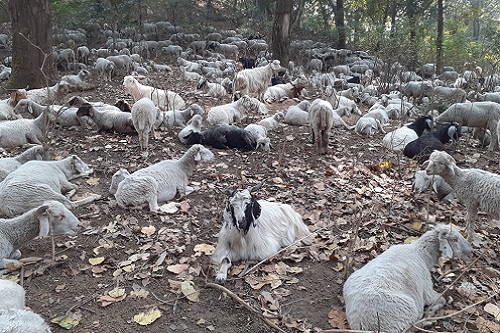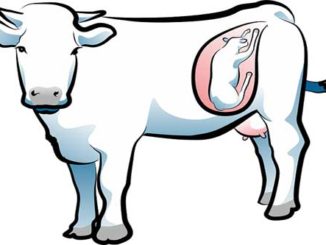In India mainly in the northern part the shepherds live a nomadic life being in migration with their Sheep and Goat throughout the year. They venture out into the ‘bugyals’ (alpine pasturelands) for summer migration from March to August and come down to the plains in winter migration from September to February. In these hilly areas Sheep and Goat husbandry is deeply linked to local culture and traditions.
Non-availability of high genetic potential males for breeding, poor management practices, inadequate nutrition, inadequate marketing infrastructure and unorganized marketing are major concerns that threat the Sheep husbandry.
Breed up-gradation of non-descript Indian sheep will aim to improve growth, body weight, reproductive efficiency, meat and wool quality and quantity, and to reduce mortality.

Artificial Insemination through Heat Synchronization in Sheep
Sheep is a seasonal (short day) breeder. However in countries like India which lies in tropical and temperate regions the breeding behavior of sheep isn’t totally seasonal. In temperate regions of India its breeding behavior is somewhat seasonal.
Sheep is less responsive to artificial insemination than other domestic animals, since oestrus cannot easily be detected without the presence of rams, insemination is less straightforward unlike bovines and ovine semen is less easy to freeze than bovine semen.
Ewes display oestrous behavior only in the presence of a ram. So to determine the time of artificial insemination it is important either to control the timing of oestrus or to detect it with male animals.In the former situation, pharmacological methods like administration of hormones are used to induce and synchronize oestrus, so that the time of the fertile period is defined. In the latter situation, either teaser ram or intact ram with an abdominal apron to prevent intromission are used to detect oestrus.
The most important limitation of the use of artificial insemination in sheep is in the method of insemination, since it is difficult to achieve an intrauterine insemination because the cervical canal of the ewe is so tortuous.
Diluents that are used for unfrozen semen include buffers that contain glucose, egg yolk–citrate or egg yolk–phosphate solutions.
The AI in sheep will either be performed intracervical or by laparoscopic intrauterine methods. In case of intracervical method fresh diluted semen will be used with approximately 200 million motile sperms and a volume about 0.1-0.2 ml in each inseminate. Semen will be deposited on the entrance fold of up to 1 cm into the cervix to deeper than 1 cm into the cervix with the help of a glass speculum with light source and a glass pipette. This method will provide a overall lambing rate of 50-60%.
In case of laparoscopic intrauterine method cryopreserved semen will be used with 20 million motile sperms and 10 million sperms will be deposited in each uterine horn with the help of laparoscope.
There are several heat synchronization protocols used in sheep like use of progesterone. In this protocol based on insertion of CIDR/ progesterone impregnated sponge intra vaginally for 12 days and suddenly removing it after 12 days results in oestrus in ewes. Then fixed time AI can be done after 48-56 hours of removal of CIDR. For increasing the chances of conception PMSG (200IU) can be administered while removing CIDR. AI is done twice to in morning and evening to increasing the rate of conception. Another protocols include use of prostaglandins (PGF2 alpha) but it has a disadvantage that if the sheep is pregnant and pregnancy is not diagnosed, it will lead to abortion.
Methodology
The Protocol for Heat Synchronization & AI is as follows-
- Selection of High Genetic Merit Rams ofbreeds like Merino and Rambouillet
- Selection and identification of ewes with tagging
- Deworming of ewes
- Balanced Concentrate Ration and Mineral mixture till lambing
- Insertion of hormone adsorbed sponge/CIDR (Controlled Internal Drug Release) after 1 week of deworming
- After 12 days withdrawal of sponges/CIDR and administration of PMSG @ 200-325 IU i/m
- Semen collection, evaluation dilution and deposition of liquid/frozen semen in ewes.
- Pregnancy diagnosis
- Continuous monitoring till expected date of lambing

Importance of Breed Up-gradation and Conclusion
Higher In-Breeding Coefficient has lead to increased mortality, stunted growth, low reproductive performance, low carcass yield, decrease in quality and quantity of wool / meat etc. Therefore sheep in India primarily produce Course Wool which has fibre diameter ranging between 22 – 40 microns and fibre length of 5 – 08 cm. Similarly Fleece Yield ranges between 1.5 – 1.7kg only.
Breed Up-gradation of non descript Indian Sheep by Artificial Insemination will lead to
- Reduce deleterious effects of inbreeding already prevalent like low birth weight, lower conception, increased mortality,more prenatal deaths.
- Improvement in wool quality by reducing wool diameter, increased staple length, higher crimps, zero medullation and better clean wool yield.
- Increase in wool production per sheep.
- Increase in average meat production per animal.
- Produce improved germplasm in the form of breeding rams and ewes.
- Excellent Feed Conversion Ratio.
- Give a flip to wool export in view of its fineness and meet the local wool demand.








Be the first to comment